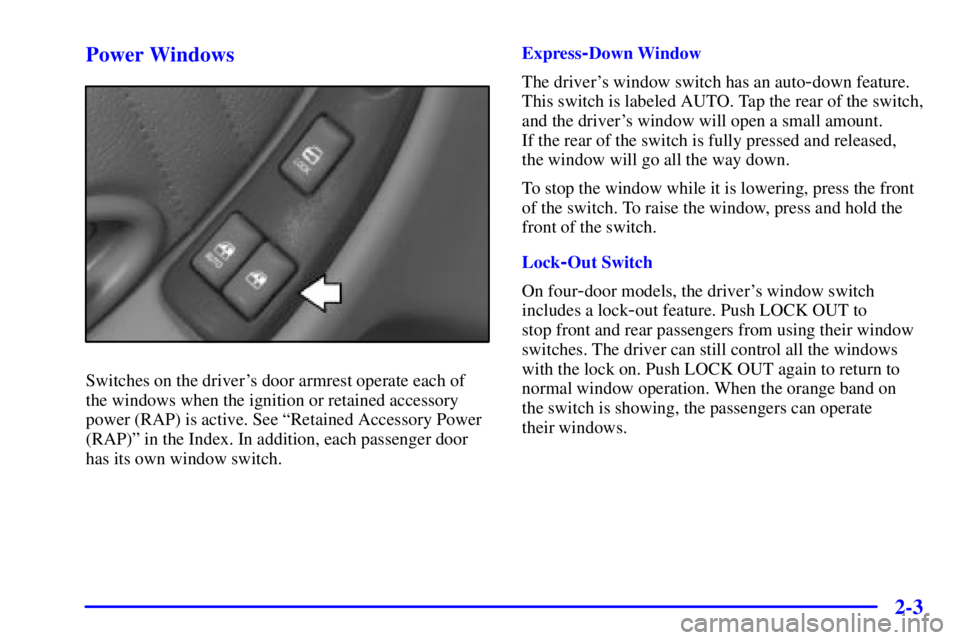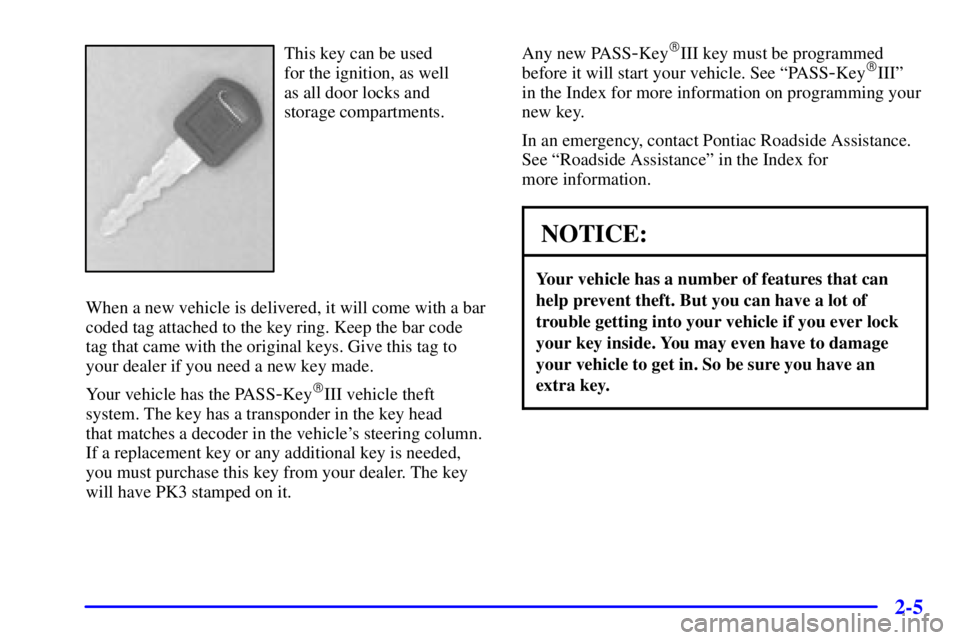Page 4 of 373
Table of Contents
Windows
Keys and Door Locks
Remote Keyless Entry System (If Equipped)
Remote Trunk Release (If Equipped)
Automatic Transaxle
Parking Brake
Tilt Wheel
Turn Signal/Multifunction Lever
Windshield Wipers
Cruise Control (If Equipped)
Exterior and Interior Lamps
Mirrors
Storage Compartments
Convenience Net (If Equipped)
Accessory Power Outlet/Auxiliary Power Connection
OnStar® System (If Equipped)
Sunroof (Option)
Instrument Panel, Warning Lights and Gages
Driver Information Center
Head-Up Display (Option) Seats and Seat Controls
Safety BeltsSupplemental Restraint System (SRS)
Restraint Systems for Children
Section
1
Section
2
Seats and Restraint Systems
Features and Controls
ii
Page 11 of 373

ix
For example,
these symbols
are used on an
original battery:
CAUTION
POSSIBLE
INJURY
PROTECT
EYES BY
SHIELDING
CAUSTIC
BATTERY
ACID COULD
CAUSE
BURNS
AVOID
SPARKS OR
FLAMES
SPARK OR
FLAME
COULD
EXPLODE
BATTERY
These symbols
are important for
you and your
passengers
whenever your
vehicle is driven:
CHILD
RESTRAINT
TOP STRAP
ANCHOR
DOOR LOCK
UNLOCK
FASTEN
SEAT
BELTS
POWER
WINDOW
AIR BAG
These symbols
have to do with
your lamps:
MASTER
LIGHTING
SWITCH
TURN
SIGNALS
PARKING
LAMPS
HAZARD
WARNING
FLASHER
DAYTIME
RUNNING
LAMPS
FOG LAMPS
These symbols
are on some of
your controls:
WINDSHIELD
WIPER
WINDSHIELD
WASHER
WINDSHIELD
DEFROSTER
REAR
WINDOW
DEFOGGER
VENTILATING
FAN
These symbols
are used on
warning and
indicator lights:
ENGINE
COOLANT
TEMP
BATTERY
CHARGING
SYSTEM
BRAKE
COOLANT
ENGINE OIL
PRESSURE
ANTI-LOCK
BRAKES
Here are some
other symbols
you may see:
FUSE
LIGHTER
HORN
FUEL
Vehicle Symbols
These are some of the symbols you may find on your vehicle. Also see ªWarning Lights and Gagesº in the Index.
Page 25 of 373

1-13
How to Wear Safety Belts Properly
Adults
This part is only for people of adult size.
Be aware that there are special things to know about safety
belts and children. And there are different rules for smaller
children and babies. If a child will be riding in your
vehicle, see the part of this manual called ªChildren.º
Follow those rules for everyone's protection.
First, you'll want to know which restraint systems your
vehicle has.
We'll start with the driver position.
Driver Position
This part describes the driver's restraint system.
Lap-Shoulder Belt
The driver has a lap-shoulder belt. Here's how to wear
it properly.
1. Close and lock the door.
2. Adjust the seat so you can sit up straight.
To see how, see ªSeatsº in the Index.
3. Pick up the latch plate and pull the belt across you.
Don't let it get twisted.
The shoulder belt may lock if you pull the belt across
you very quickly. If this happens, let the belt go back
slightly to unlock it. Then pull the belt across you
more slowly.
Page 27 of 373
1-15
Shoulder Belt Height Adjuster (4-Door Models)
Before you begin to drive, move the shoulder belt
adjuster to the height that is right for you.To move it down, squeeze the release lever and the
shoulder belt guide as shown and move the height
adjuster to the desired position. You can move the
adjuster up just by pushing up on the shoulder belt
guide. After you move the adjuster to where you want it,
try to move it down without squeezing the release lever
to make sure it has locked into position.
Adjust the height so that the shoulder portion of
the belt is centered on your shoulder. The belt should
be away from your face and neck, but not falling off
your shoulder.
Page 64 of 373
1-52
Four-Door Models�If your vehicle has the child restraint locking
feature on the shoulder belt retractor, pull the rest
of the shoulder belt all the way out of the
retractor to set the lock.
To tighten the belt, feed the shoulder belt back
into the retractor while you push down on the
child restraint. You may find it helpful to use
your knee to push down on the child restraint as
you tighten the belt.
�If your vehicle doesn't have the child restraint
locking feature on the shoulder belt retractor,
tighten the belt by pulling up on the shoulder belt
while you push down on the child restraint. You
may find it helpful to use your knee to push down
on the child restraint as you tighten the belt.
Page 70 of 373

2-
2-1
Section 2 Features and Controls
Here you can learn about the many standard and optional features on your vehicle, and information on starting,
shifting and braking. Also explained are the instrument panel and the warning systems that tell you if everything
is working properly
-- and what to do if you have a problem.
2
-2 Windows
2
-4 Keys
2
-6 Door Locks
2
-9 Remote Keyless Entry System (If Equipped)
2
-13 Multifunction Alarm Locks and
Lighting Choices
2
-24 Trunk
2
-26 Theft
2
-27 Content Theft-Deterrent (If Equipped)
2
-28 PASS-Key� III
2
-30 New Vehicle ªBreak-Inº
2
-31 Ignition Positions
2
-32 Starting Your Engine
2
-35 Engine Coolant Heater (Option)
2
-37 Automatic Transaxle Operation
2
-41 Parking Brake
2
-42 Shifting Into PARK (P)2
-44 Shifting Out of PARK (P)
2
-44 Parking Over Things That Burn
2
-45 Engine Exhaust
2
-45 Running Your Engine While You're Parked
2
-47 Turn Signal/Multifunction Lever
2
-52 Exterior Lamps
2
-54 Interior Lamps
2
-56 Mirrors
2
-61 Storage Compartments
2
-66 OnStar� System (If Equipped)
2
-69 Sunroof (Option)
2
-70 The Instrument Panel -- Your
Information System
2
-74 Warning Lights, Gages and Indicators
2
-87 Driver Information Center (DIC)
2
-89 Trip Computer (If Equipped)
2
-92 Head-Up Display (Option)
Page 72 of 373

2-3 Power Windows
Switches on the driver's door armrest operate each of
the windows when the ignition or retained accessory
power (RAP) is active. See ªRetained Accessory Power
(RAP)º in the Index. In addition, each passenger door
has its own window switch.Express
-Down Window
The driver's window switch has an auto
-down feature.
This switch is labeled AUTO. Tap the rear of the switch,
and the driver's window will open a small amount.
If the rear of the switch is fully pressed and released,
the window will go all the way down.
To stop the window while it is lowering, press the front
of the switch. To raise the window, press and hold the
front of the switch.
Lock
-Out Switch
On four
-door models, the driver's window switch
includes a lock
-out feature. Push LOCK OUT to
stop front and rear passengers from using their window
switches. The driver can still control all the windows
with the lock on. Push LOCK OUT again to return to
normal window operation. When the orange band on
the switch is showing, the passengers can operate
their windows.
Page 74 of 373

2-5
This key can be used
for the ignition, as well
as all door locks and
storage compartments.
When a new vehicle is delivered, it will come with a bar
coded tag attached to the key ring. Keep the bar code
tag that came with the original keys. Give this tag to
your dealer if you need a new key made.
Your vehicle has the PASS
-Key�III vehicle theft
system. The key has a transponder in the key head
that matches a decoder in the vehicle's steering column.
If a replacement key or any additional key is needed,
you must purchase this key from your dealer. The key
will have PK3 stamped on it.Any new PASS
-Key�III key must be programmed
before it will start your vehicle. See ªPASS
-Key�IIIº
in the Index for more information on programming your
new key.
In an emergency, contact Pontiac Roadside Assistance.
See ªRoadside Assistanceº in the Index for
more information.
NOTICE:
Your vehicle has a number of features that can
help prevent theft. But you can have a lot of
trouble getting into your vehicle if you ever lock
your key inside. You may even have to damage
your vehicle to get in. So be sure you have an
extra key.